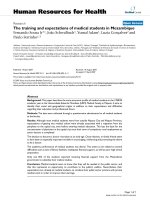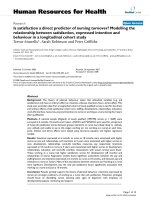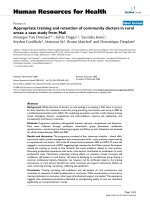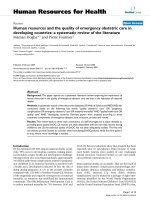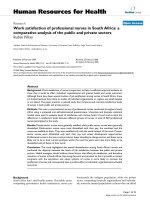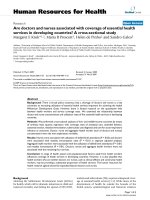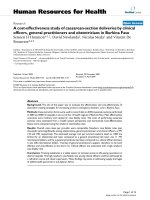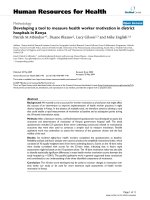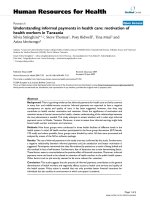báo cáo sinh học:" Job satisfaction and motivation of health workers in public and private sectors: cross-sectional analysis from two Indian states" ppt
Bạn đang xem bản rút gọn của tài liệu. Xem và tải ngay bản đầy đủ của tài liệu tại đây (311.43 KB, 11 trang )
RESEARC H Open Access
Job satisfaction and motivation of health workers
in public and private sectors: cross-sectional
analysis from two Indian states
David H Peters
1*
, Subrata Chakraborty
2
, Prasanta Mahapatra
3
, Laura Steinhardt
1
Abstract
Background: Ensuring health worker job satisfaction and motivation are important if health workers are to be
retained and effectively deliver health services in many developing countries, whether they work in the public or
private sector. The objectives of the paper are to identify important aspects of health worker satisfaction and
motivation in two Indian states working in public and private sectors.
Methods: Cross-sectional surveys of 1916 public and private sector health workers in Andhra Pradesh and Uttar
Pradesh, India, were conducted using a standardized instrument to identify health workers’ satisfaction with key
work factors related to motivation. Ratings were compared with how important health workers consider these
factors.
Results: There was high variability in the ratings for areas of satisfaction and motivation across the different
practice settings, but there were also commonalities. Four groups of factors were identified, with those relating to
job content and work environment viewed as the most important characteristics of the ideal job, and rated higher
than a good income. In both states, public sector health workers rated “good employment benefits” as significantly
more important than private sector workers, as well as a “superior who recognizes work”. There were large
differences in whether these factors were considered present on the job, particularly between public and private
sector health workers in Uttar Pradesh, where the public sector fared consistently lower (P < 0.01). Discordance
between what motivational factors health workers conside red important and their perceptions of actual presence
of these factors were also highest in Uttar Pradesh in the public sector, where all 17 items had greater discordance
for public sector workers than for workers in the private sector (P < 0.001).
Conclusion: There are common areas of health worker motivation that should be considered by managers and
policy makers, particularly the importance of non-financial motivators such as working environment and skill
development opportunities. But managers also need to focus on the importance of locally assessing conditions
and managing incentives to ensure health workers are motivated in their work.
Background
Until recently, human resources have been overlooked
during the course of health sector reforms [1,2]. The
Joint Learning Initiative, World Health Organization,
and the Global Health Workforce Alliance have been
focusing attention on health workers, particularly on the
pervasive problems with staffing shortages, poor job
conditions, low remuneration, and extensive migration
[3,4]. As the backbone of the health system, health
workers usually account for the largest share of public
expenditures on health. The presence of high-quality,
motivated staff is a key aspect of health system perfor-
mance, but also one of the most difficult inputs to
ensure [5,6]. Health worker job satisfaction, which can
be defined as ‘the attitude towards one’sworkandthe
related emotions, beliefs, and behaviour’,resultsfrom
complex interactions between on-the-job experience,
organizational environment, and motivation. Job satis-
faction is inextricably linked to motivation, and both
involve cognitive, affective, and behavioural processes,
* Correspondence:
1
Johns Hopkins University Bloomberg School of Public Health, Baltimore,
USA
Full list of author information is available at the end of the article
Peters et al. Human Resources for Health 2010, 8:27
/>© 2010 Peters et al; lice nsee BioMed Central Ltd. This is an Open Access article distributed under the terms of the Creative Commons
Attribution License ( which permits unrestricted use, distribution, and reproduction in
any medium, provided t he original work is properly cited.
with worker motivation commonly understoo d as the
reason why workers behave as they do towards achiev-
ing personal and organizational goals. Neither job satis-
faction nor motivation is directly observable, but both
have been identified as critical to the retention and per-
formance of health workers [7-9]. Some authors contend
that the main determinant of healt h sector performance
is health worker motivation, and while resource avail-
ability and worker competence are necessary, they are
not sufficient [10]. In addition to technical training,
health workers must work in environments with incen-
tives in place that reward high-quality performance. To
this end, an understanding o f employee motivation is
necessary to design systems with the right incentives.
In India, low job satisfaction among health workers in
the public sector is evident from the highest reported
rates of absenteeis m of any country [11], while concerns
persist about the performance and motivations of a het-
erogeneous private health sector [12]. Notwithstanding
the importance of understanding worker satisfaction in
the local context, though there is relatively little empiric
information about health worker job satisfaction, moti-
vation, and performance in many developing countries
[13,14], and in India in particular.
Thepurposeofthisstudyistoidentifyimportant
aspects of health workers’ job satisfaction and motiva-
tion in different settings in two states in India: Andhra
Pradesh (AP) and Uttar Pradesh (UP). The study identi-
fies and assesses differences in the perceived importance
and actual presence of job characteristics related to
motivation of doctors and nurses in both public and pri-
vate sectors in the two states. The study was part of a
larger research program conducted by Indian institu-
tions to examine options for India’s future health sys-
tems, with AP and UP representing distinct regions of
the countr y [12]. Identifying the disti nct conditions that
affect health worker satisfaction and motivation in each
sector and state can provide a basis for considering poli-
cies and management approaches to improve work con-
ditions that are different in each setting.
Previous analysis on public sector health workers
argue that the lack of adequate remuneration is the
main health worker grievance in low income countries,
and the main rea son why public sector health workers
are frequently missing or wo rking elsewhere [15]. The
Joint Learning Initiative Report also highlights the
importance of management culture and working condi-
tions in affecting motivation, and cites small studies in
four African and Asian countries tha t show how moti-
vating factors differ widely, with factors other than
remuneration having higher importance [16].
The 2006 World Health Report identified ten major
strategies to improve the performance of health workers,
including those rel ated to improving job conditions and
providing sup portive supervision [4]. Paying health
workers sufficiently and on-time were also identified as
necessary for improving motivation of health workers,
particularly to recruit and retain staff, and to prevent
absenteeism and collection of informal payments from
patients. Efforts to improve health worker motivation
have focused on financial incentives, including pay-for-
performance [17,18], particularly since wages for health
workers tend to be low [4]. Yet well-intentioned efforts
to improve financial incentives for health workers can
actually undermine morale and lead to negative conse-
quences for health workers [19,20]. Zimbabwe recently
made a m ore concerted effort to address public health
sector worker motivation through a series of reforms,
including financial reforms, management strengthening,
decentralization, and contracting out. However, the mis-
managed reform implementation process and the gov-
ernment’s poor communication with health workers
undermined the potential positive impacts of the
reforms [21].
Theories on health worker motivation
The factors affecting worker satisfactio n and motivation
has an extensive literature and many theories, some of
which has been reviewed by Dolea and Adams [22]. In
his seminal work on the Principles of Scientific Manage-
ment, Frederick Taylor advocated providing financial
incentives to workers and breaking down work to the
one best way to perform tasks to increase their produc-
tivity [23], an approach that frequently led to worker
resentment and strikes [24]. Content theories were later
developed to link w orker motivation to the satisfaction
of needs. Motivating factors related to job content or
other factors related to the job context are seen as con-
tributing to job satisfaction [25-27]. Process theories
emphasized subjective expectations or the values of
workers as influencing their motivation and work effort
[28-30]. Kanfer builds on these theories to stress the
importance of employees’ willingness and ability to carry
out the goals of the organization in which they work
[31]. Job characteristics have been identified as critical
determinants of health worker motivation and satisfac-
tion [7,8], and have also been described as a core
domain in the measurement of health worker motiva-
tion, along with organizational commitment and co n-
scientiousness [9]. In this study, we build on these
theories to assess workers’ subje ctive assessments of job
satisfaction related to the content of the job and its con-
text, adapting an instrument called the Job Descriptive
Index (JDI) [32]. We focus on those motivating factors
in the work environment that are amenable to change,
and contrast workers’ assessment of how important
these factors are to them with their assessment of how
satisfied they are with their current conditions.
Peters et al. Human Resources for Health 2010, 8:27
/>Page 2 of 11
Indian context
India has a rapidly growing economy, yet is still a low
income country with high levels of poverty and a com-
plex health system with considerably different conditions
prevailing in its different states [33]. Though they are
both considered major states in India (AP’spopulation
is estimated at 76 million, UP at 166 million, as of
2001), AP is further advanced in the health transition
than UP, as shown by lower child mortality rates (86
deaths per 1000 births in children under 5 in AP, versus
123 in UP) and fertility levels (2.5 children per women
in AP versus 4.8 in UP) [33]. Compared to other Indian
states, both AP and UP provide less than the median
level of public spending on health, both are regressive to
the poor in their public spending on health, and both
have large private sectors providing ambulatory and
inpatient hospital care, which continues to attract health
workers from the public sector [33]. AP is considered a
friendlier environment for private business than UP, and
has reaped greater benefits from the rapid expansion of
technology, so that w ork environments are expected to
differ. In both states, the public health sector has suf-
fered from inadequate investment and support for
operations, adversely affecting work conditions. This has
undermined the ability of health workers to deliver high
quality care in the public sector, and provides a ratio-
nale for informal payme nts and absentee ism as a means
of securing a higher income. Regulation of the private
sector is weak throughout India [34], and many private
organizations have created work environments that deli-
ver poor quality health care in both AP [35] and UP
[36], a situation which is not encouraging to those
health workers aspiring to high professional standards.
On the other hand, the financial “bottom-line” is a
much bigger concern in private sector organizations,
and the earning potential is expected to be considerably
higher than in the public sector.
Methods
The studies in each state were conducted by different
research organizations as part of larger studies on the
health sector. Although each location examined slightly
different research topics , the job satisfaction part of the
study followed a common protocol. A sampling frame
of health providers did not exist in either state, and
each organization needed to take a slightly different
approach to arrive at random samples of health
workers.
In the case of AP, a database of public and private
facilities was held by the Institute of Health Systems,
which was updated through interviews with practicing
local doctors, and officials from medical colleges, profes-
sional associations, and other agencies. Three strata of
districts were purposely identified to represent different
socioeconomic areas of the state, with one district
selected at random from each stratum. Three large hos-
pitals (those with over 100 beds), 20 small hospitals, and
25 primary health clinics and/or solo practitioners were
randomly selected from the lists of public and private
facilities in e ach district, using a random starting point
and fixed selection interval. Doctors and nurses were
selected at random from a list of all doctors and nurses
usually working at each facility, according to the size of
the facility (up to four doctors and two nurses at large
hospitals, up to four health workers at small hospitals,
and one for solo practitioners). Names of public provi-
ders who may have been assigned to a facility but had
never or rarely showed up, or who were on official
leave, were not included in our sample. In UP, one dis-
trict was randomly selected from each of three strata of
districts representing different socioeconomic areas of
the state, as was done in AP. A list of public facilities
had been updated by the state’s Department of Health
and Family Welfare , and a random sample was taken of
70 large hospitals, 70 small hospitals, and 100 primary
health centers, with health providers randomly selected
from a list of providers in a similar manner to AP. A
larger sample was taken because it was part of a baseline
evaluation of a quality improvement project in the pub-
lic sector, which was conducted by a separate organiza-
tion. To obtain a list of private providers, the starting
point was a database of facilities maintained by the UP
Nursing Home Association, which was supplemented by
interviews with local doctors, medical colleges , and pro-
fessional associations, and then confirmed by conducting
a census of providers in the selected districts to confirm
their presence. In each of the three districts, four large
private hospitals, 22 small private hospitals, and 28 solo
practitioners were randomly selected, with doctors and
nurses selected at each facility from complete lists of
doctors and nurses using the same approach as in AP.
Experienced data collectors were trained in the study
protocols, along with standardized reference manuals
and supervision. Nearly all the data were collected in
one or two visits to a facility, but up to six visits were
conducted to ensure data completeness. Further d etails
of the full study methods are reported elsewhere [36,37].
A 17-item instrument was developed based on the JDI
[32] to assess the importance (in an ideal job) and actual
presence (in current job) of attributes specific to the job
and their work environment as a measure of job satis-
faction [31]. The questionn aires were pilot tested in five
health care institutions of different types and used to re-
phrase the items. Fifteen items cover five main areas,
namely: (a) work, (b) supervision, (c) pay, (d) promo-
tions, and (e) coworkers. Because of the concerns about
governanc e and corruption in the health sector, and the
expectation that these concerns may differ between AP
Peters et al. Human Resources for Health 2010, 8:27
/>Page 3 of 11
andUP,andacrosspublicandprivatesectors[12],
items were added to examine these aspects of the work
environment: one item on political interference and the
other on briber y. Each of the 17 item s was presented to
the selected doctors and nurses for self-administration.
Health workers were first asked to give their opinion as
to how important the 17 factors are for the ideal job.
The five point rating scale consisted of: (0) of no impor-
tance; (1) of little importance; (2) of some importance;
(3) very important; and (4) extremely important. The
same items were used again, the second time asking the
health workers to rate the extent to which these factors
were present in their job. The five point rating scale
consisted of: (0) not there at all; (1) present a little; (2)
present to a small extent; (3) present to a large extent;
and (4) fully present. We conducted exploratory analysis
analyzing the Likert scales as continuous, ordinal, and
binary variables (created from the highest two outcomes
- (3) & (4) - as “Important"/"Present” compared with the
low and neutral r esponses - (0) to (2) - as “Not Impor-
tant"/"Not Present”). Since the results were similar, we
show the binary outcome results here for simplicity.
Inter nal consistency of the scales was assess ed by Cron-
bach’s alpha, and found to be adequate: 0.76 for the
ideal scale, and 0.79 for the actual scale. To show the
extent of discrepancy between perceived importance and
actual presence of each item, we created a dichotomous
variable for discordanc e for each attribute whenever an
attribute was thou ght to b e “Important” but “Not
Present”.
Descriptive analysis was performed to delineate the
gender, age, job (doctor or nurse) and public/private
affiliation of the sample. We conducted a principal com-
ponents analysis on the importance ratings (in an ideal
job) to examine the structure of the respo nses and deter-
mine whether unique patterns of items can be identified
to determine whether the 17 “ideal job” attributes could
be collapsed into common categories of health worker
preferences. The principal co mponents analysis involved
principal component extraction with a Varimax rotation
done initially on each of the four groups (public/private
in AP, UP) and then the combined sample.
Logistic regression models were used for each binary
outcome variable to test the significance of dif ferences
in the public vs. private sectors for each state adjusting
for sex, job, and age category using dummy indicator
variables in the following equation:
Log P 1 P
job characteristic present job characteristic pres
/ −
eent
1234
B B Public Private B Sex B Job B Age catego
()
⎡
⎣
⎤
⎦
=
+
()
+++
0
/rry
Wilcoxon signed rank tests were used to make com-
parisons between the ratings of public and private sector
workers within each state.
Results
Demographics of health workers
A total of 1916 health worke rs completed the question-
naire: 621 from AP and 1295 from UP. Although four
private facilities refused to participate in the study
(1.2%),wewereabletoobtain100%responseratefrom
the health care workers at participating facilities. Miss-
ing data for individual items ranged from 0.3% to 3.5%,
which were dropped from the an alysis. Forty-seven per
cent of respondents in AP were employed in the public
sector, while 68% of respondents in UP were public sec-
tor health workers. In both states, and within each
employment group (public sector and private sector), a
majority of respondents were male, ranging from 52% of
public sector respondents in AP to two-thirds of public
sector respondents i n UP. Most respondents were
between 30 and 45 years of age, and most were doctors,
with a range from 65.2% doctors (vs. nurses) in the UP
public sector to 82.4% in the AP public sector. Further
details on respondent demographics are provided in
Table 1 below.
Identification of main factors of job characteristics
The principal component analysis yielded four distinct
components with Eigenvalues greater than one for the
combined sample and for the UP-Public sector sample,
whereas the UP-Private sector, AP-Public sector, and
AP-Private sector samples had five components. Yet the
patterns of items for components were very similar
acr oss groups when the analysis of each group was lim-
ited to four components, so the combined sample is
used to describe the components (Table 2). The first
component contains factors that relate to the nature of
the job itself and the work environment, including attri-
butes related to the challenging nature of the work, phy-
sical conditions of work, relationships with colleagues,
and preparedness for the task at hand. The second
Table 1 Characteristics of health providers
STATE (AP) STATE (UP)
Public Private Public Private
n = 290 n = 331 n = 875 n = 420
Sex
Male 55.2% 57.7% 66.7% 58.6%
Female 44.8% 42.3% 33.3% 41.4%
Age
< 30 Years 10.7% 23.9% 5.6% 20.7%
30-45 Years 68.6% 50.5% 69.0% 58.3%
> 45 Years 20.7% 25.7% 25.4% 21.0%
Position
Doctor 82.4% 74.0% 65.2% 79.1%
Nurse 17.6% 26.0% 34.8% 21.0%
Peters et al. Human Resources for Health 2010, 8:27
/>Page 4 of 11
component relates more to the extrinsic benefits of the
job, including income, employment benefits, time for
family life, and job location. The third category emer-
ging from the principal component analysis includes
autonomy and job security. Finally, the last category
relates to transparency, and includes not having to pay
bribes to get what is desired and not having one’swork
influenced by political decisions. We therefore refer to
the four ideal job preference categories as ‘job content
& work environment’, ‘extrinsic benefits,’‘autonomy &
job security,’ and ‘transparency’.
Importance ratings for ideal job characteristics
Nearly all items on the ideal job attributes instrument
received high average scores, with the per cent rated as
“important” (3 or 4 on the 0 to 4 scale) greater than
75% for all items other than “keeping job as long as you
want” and “independence form interference"(Table 3).
The five job characteristics with the highes t importance
rating overall were “good working relationships with col-
leagues”, “physical conditions”, “training opportunities”,
“tools to use skills on the job”,and“challenging work”,
all of which are included in the ‘job content and work
environment’ component. Contrary to what might be
expected according to popular belief, “good income” was
not rated in the top ten most important job characteris-
tics overall; it was the third least important characteris-
tic of an ideal job, according to respondents.
Perception s of ideal job characteristic were fairly similar
across sectors in AP. In this state, doctors and nurses in
both public and private sectors had the same top five
important job characteristics ("good working relation-
ships with colleagues” and “good physical conditions”
were numbers 1 and 2, respectively, with the order of
numbers 3-5 varying slightly). In UP, both public and
private sector workers gave the highest ratings to “good
working relationships with colleagues”. However, in the
UP public sector, “trusted by clients” and “opportunity
to advance” also made it into th e top five most impor-
tant job characteristics (along with “tools to use skills
on the job and “training opportunities”). In the UP pri-
vate sector, “trusted by clients” was also in the top five
items of importance, along with “good physical condi-
tions”, “training opportunities,” and “tools to use skills
on the job”.
The most important items for public and private sec-
tor workers in both states involved ‘jo b content a nd
work environment’ factors. However, there were also
differences between public and private sector workers.
In both states, the largest difference between public and
Table 2 Principal component analysis of importance ratings of job characteristics by health providers in both states
(public and private)
Rotated component matrix
Component correlation
1
Job content &
work environment
2
Extrinsic
benefits
3
Autonomy &
security
4
Transparency
Challenging work 0.714 -0.028 0.095 0.039
Training opportunities 0.680 0.158 -0.064 -0.007
Tools to use skills on the job 0.667 0.202 0.131 0.137
Good working relationship with colleagues 0.602 0.177 -0.025 -0.053
Good physical conditions 0.591 0.203 0.028 0.072
Knowing what you are expected to do 0.511 0.280 0.156 0.079
Good employment benefits 0.171 0.748 0.128 -0.040
Good income 0.013 0.644 0.048 0.142
Opportunity to advance 0.360 0.617 0.125 -0.043
Time for family life 0.089 0.563 -0.093 0.039
Based in good location 0.343 0.520 0.082 -0.082
Keeping job as long as you want 0.081 0.148 0.735 0.078
Independence from interference 0.046 0.017 0.727 -0.174
Not having work influenced by political decisions 0.002 0.038 -0.270 0.666
Not having to pay bribes to get what you want 0.099 -0.020 0.107 0.787
Superior who recognized work 0.351 0.488 0.228 -0.015
Trusted by clients 0.460 0.147 0.335 0.378
Notes: Extraction method: principal component analysis.
Rotation method: varimax with Kaiser normalization.
Attributes in bold indicate correlation of 0.5 or greater
Peters et al. Human Resources for Health 2010, 8:27
/>Page 5 of 11
private sector workers involved factors related to extrin-
sic benefits. “Good employment benefits”,wasrated
much higher in importance in the public sector than the
private sector (76% compared to 53% in AP, P <0.001;
94% compared to 66% in UP, P < 0.001). Highly signifi-
cant differences between public and private sectors
across both states were evident for “superior who recog-
nizes work” and “based in a good location”. In AP, pub-
lic sector workers also rated “knowing what you are
expected to do” (83% compared to 72%, p < 0.01),
“training opportuni ties” (90% compared to 82%, p <
0.001) and “indep endence from interferenc e” (59% com-
pared to 50%, p < 0.01) significantly higher than their
private sector counterparts. In UP, public sector workers
rated as significantly higher than the private sector
“time for family life”, “tools to use skills on the job,”
“challenging work,”“good income”,and“opportunity to
advance.” Transparency factors were also more impor-
tant to private sector workers than public sector workers
in UP, as they rated “not having work influenced by
political decisions” as significantly more important (See
Table 3).
Ratings of actual presence of characteristics in current
job
Analysis of the perceived actual presence of the same 17
job characteristics als o revealed differences by state and
by public and private sector workers (Table 4). Actual
presence of most job attributes was lower than the per-
ceived importance, across both states and sectors. In
AP, actual condition s were rated as better in the private
sector than the public sector for 13 of the 17 attributes
(Wilcoxon signed-rank test p < 0.05), whereas in UP,
they were rated as better in the private sector for 15 of
the 17 attributes (Wilcoxon signed rank test p < 0.01).
In both UP and AP, private sector workers rated “train-
ing opportunities” as more present than public sector
workers (though this difference was only significant in
AP), along with “tools to use skills on the job”, “not
Table 3 Percent of health providers rating job
characteristics as important, by state and public/private
sector
INDICATOR STATE(AP) STATE(UP)
Public Private Public Private
Job content & work environment
Challenging work 88.6 83.9 93.3 91.6*
Training opportunities 90.3 81.5** 96.0 93.2
Tools to use skills on the job 83.4 84.2 96.8 93**
Good working relationships with
colleagues
93.8 90.6 98.7 97.8
Good physical conditions 90.7 90.6 93.5 94.2
Knowing what you are expected to
do
83.0 72.3** 92.3 89.6
Extrinsic benefits
Good employment benefits 76.2 53.3*** 94.0 65.8***
Good income 74.4 66.5 82.1 73.4***
Opportunity to advance 72.0 65.3 94.3 77.7***
Time for family life 77.9 75.8 93.9 85.5***
Based in good location 83.1 72.5** 93.8 84.3***
Autonomy & security
Keeping job as long as you want 57.2 52.7 70.2 73.3
Independence from interference 58.9 49.7* 56.0 61.6
Transparency
Not having to pay bribes to get
what you want
75.5 74.1 85.5 87.9
Not having work influenced by
political decisions
80.3 79.5 74.0 85.9***
Other
Trusted by clients 70.6 74.4 94.8 93.2
Superior who recognizes work 74.7 60.7*** 92.9 68.8***
* P < 0.05
** P < 0.01
*** P < 0.001
Note: results adjusted for sex, age, and profession
Table 4 Percentage of health providers rating job
characteristics as present, by state and public/private
INDICATOR STATE(AP) STATE(UP)
Public Private Public Private
Job content & work environment
Challenging work 61.4 62.3 54.0 74.0***
Training opportunities 41.3 52.3 29.3 49.0***
Tools to use skills on the job 34.8 55.3*** 37.6 75.5***
Good working relationships with
colleagues
83.4 79.0 80.5 90.1***
Good physical conditions 54.2 61.5 43.6 78.7***
Knowing what you are expected to
do
61.2 62.1 63.4 79.5***
Extrinsic benefits
Good employment benefits 43.1 22.5*** 45.3 22.2***
Good income 34.6 39.7 43.5 45.2
Opportunity to advance 33.7 36.5 34.1 41.4*
Time for family life 32.9 38.5 47.4 55.0*
Based in good location 47.8 56.9* 35.2 78.7***
Autonomy & security
Keeping job as long as you want 45.5 50.5 49.3 71.7***
Independence from interference 37.4 41.8 39.6 49.9***
Transparency
Not having to pay bribes to get
what you want
72.8 72.7 70.0 89.1***
Not having work influenced by
political decisions
70.2 79.8** 42.8 89.0***
Other
Trusted by clients 56.7 69.3** 78.5 91.5***
Superior who recognizes work 50.3 43.6* 53.0 43.4*
* P < 0.05
** P < 0.01
*** P < 0.001
Note: results adjusted for sex, age, and profession
Peters et al. Human Resources for Health 2010, 8:27
/>Page 6 of 11
having work influenced by political decisions”, “tr usted
by clients”,and“based in good location”. Private sector
workers in the UP rated nearly all items as more present
than their public sector counterparts. The only item
where there was no difference between public and pri-
vate sector in UP involved “good income”,whichwas
also not different in AP. The only areas where public
sector workers rated present conditions as significantly
better than in the private sector involved “good employ-
ment benefits” and “superior who recognized work”,
which were higher in the public sector in both states.
Discordance between importance and actual presence of
job characteristics
A summary of the discordance scores is shown in Table 5.
The good news is that the most highly ranked item of
importance - “good working relationships with colleagues”
- was usually present (missing for only 16% of health
workers), indicating that health workers for the most part
are experiencing good relationships with colleagues they
highly value. However, there are numerous findings of
concern. One is the relatively high levels of discordance,
with the highest discordance rates occurring in three of
the items considered among the most important: “training
opportunit ies” (55% discordance overall), “opportun ity to
advance” (50% overall), and “tools to use skills on the job”
(47% overall). Public sector workers also had higher levels
of discordance than private sector workers. The public
sector discordance scores were significantly higher for all
indicator s in UP (Wilcoxo n signed rank test P = 0. 0003) ,
and all but one indicator in AP (Wilcoxon signed rank test
P = 0.0004). There were particularly large difference s
(greater than 30 percentage points) between public and
private sectors in the UP, including “based in a good loca-
tion”, “good physical conditions”,and“not having w ork
influenced by political decisions” (see Table 5).
Discussion
Main factors describing health worker satisfaction
The factor analysis demonstrated that groupings of vari-
ables are largely consistent with earlier results on
worker satisfaction, but did not correspond exactly to
the indices on which the instrument was based. Our
results show that while work and co-worker factors have
Table 5 Percentage of health providers rating job characteristics as discordant, by state and public/private
(discordant = important but not present) †
INDICATOR STATE (AP) STATE (UP)
Public Private Public Private
Job content & work environment
Challenging work 31.8% 26.3% 41.1% 20.0%***
Training opportunities 51.0% 33.4%*** 67.7% 46.9%***
Tools to use skills on the job 54.3% 35.4%*** 59.8% 22.2%***
Good working relationships with colleagues 13.8% 16.8% 19.0% 9.2%***
Good physical conditions 39.2% 31.2% 51.2% 18.0%***
Knowing what you are expected to do 29.1% 16.4%*** 31.5% 16.7%***
Extrinsic benefits
Good employment benefits 39.2% 34.6% 50.0% 47.2%**
Good income 44.8% 33.6%* 44.8% 36.3%***
Opportunity to advance 43.9% 34.0%** 61.4% 42.2%***
Time for family life 47.8% 42.6% 49.2% 35.3%***
Based in good location 39.8% 21.9%** 60.2% 13.9%***
Autonomy & security
Keeping job as long as you want 23.4% 16.6%** 26.1% 15.1%***
Independence from interference 32.2% 19.2%** 28.1% 23.5%*
Transparency
Not having to pay bribes to get what you want 10.5% 6.0%* 20.5% 4.7%***
Not having work influenced by political decisions 16.6% 8.0%** 37.5% 5.2%***
Other
Trusted by clients 18.4% 11.0%** 18.4% 7.1%***
Superior who recognizes work 34.6% 24.8%** 41.4% 31.6%**
† In bold: attributes with the top 5 importance ratings
* P < 0.05
** P < 0.01
*** P < 0.001
Note: results adjusted for sex, age, and profession
Peters et al. Human Resources for Health 2010, 8:27
/>Page 7 of 11
merged into one group, pay and promotions have
merged int o another group. The three items under
supervision were distributed into different groups. One
supervision item, namely “knowing what you are
expected to do” merged with the job content and work
environment group, the other item “superior who recog-
nized work” remained separate. Its correlation with the
second component of extrinsic benefits (0.488) was
sligh tly higher than its correlation with the first compo-
nent (0.351) of ‘job content and work environment’.
Less interferen ce by superiors, the third ite m under
supervision emerged in a distinct group along with job
security. The sixth group of items on Transparency
remained separate. These findings suggest that investiga-
tions on worker satisfaction and motivation should be
customized to the group under investigation, and that
assumptions ab out motivating factors sh ould not be
based exclusively on existing theories.
Contrary to common perceptions, many more employ-
ees rated motivating factors like “good working relation-
ships with colleagues” (96%), “training opportunities”
(92%), and environmental factors, such as having “tools
to use skills” (92%), and “good physical conditions”
(93%) as more important than income (76%). It is possi-
ble that respondents did not want to appear selfish and
report remuneration as a higher motivating factor, even
on a self- reporting instrument. Howe ver, in Ghana,
health workers overwhelming ly identified low salaries as
the main source of dissatisfaction on an interviewer-
administered questionnaire [38]. In AP and UP, it may
also be that those workers for whom remuneration is
most important may be more likely to be absent from
work in order to pursue other sources of income, parti -
cularly in the public sector. Alternatively, public health
worker incomes may be comparable to what they can
earn in the private labour market, and their expectations
are influenced by this. Nonetheless, the prominence of
non-financial motivating factors make it difficult to
argue that better salaries alone will significantly improve
health worker motivation, as other studies in Africa
have begun to conclude [39,40].
Our findi ngs on the importance ratings of various job
characteristics are also largely consistent with findings
from other studies conducted in the United States. For
example, Cashman and colleagues found that doctors
wanted autonomy and job status above a high income,
and regarded extrinsic benefits as less importa nt [41].
Gray concluded that extrinsic benefits did not feature
prominently among nurses, while improved communica-
tions with and a caring boss were considered important
[42]. But these nurses wanted better monetary compen-
sation more than anything else. Another study of nurses
by Tumulty, Jernigan, and Kohut found intrinsic moti-
vating factors to be more important than extrinsic ones
[43]. Yet another study on the nursi ng profession found
that the major motivating factors for nurses were recog-
nition, the work itself and responsibility [44].
A review of 12 empirical studies of motivation in both
developing and developed countries found that seven
major job characteristics were important determinants
of motivation (work itself; relationships at work; work-
place conditions; opportunities for personal develop-
ment; pay/rewards; management practices; and
organizational policies), but the relative importance of
these factors varied widely depending on the setting and
methodologies used [22] . A study in Vietnam, (included
in the review just cited) found that the main motivating
factors for health workers were appreciation by man-
agers, colleagues and the community, a stable job,
income, and training, while the primary factors f or dis-
satisfaction were low salaries and difficult working con-
ditions [45]. Another study in Jordan and Georgia, also
included in the revi ew by Dolea and Adams, found that
the two countries exhibited many similarities among key
motivat ional determinants, including self-efficacy, pride,
man agement openness, job properties, and values; how-
ever, some diverge nt results indicated the importance of
local culture on motivational issues [46]. This interpre-
tation is consistent with the findings in AP and UP.
Differences in employment environment between the two
states
Employee ratings of the importance and actual presence
of various job characteristics is an indicator of differences
in the human resource environment of the respondents.
The analysis of health worker ratings of importance and
presence of specific job characteristics in the UP and AP
health sectors showed that context, specifically geopoliti-
cal setting and employment sector (public versus private),
is extremely important in assessing health worker satis-
faction. Overall, importance ratings tended to be higher
in UP compared to AP, particularly for employment ben-
efits and good income, opportunity to advance, time for
family life, being based in a good location, keeping the
job as long as you want, not having to pay bribes to get
what you want, trust by clients, and having a superior
who recognizes one’s work.
Differences in employment environment between private
and public sector
Differences in employee ratings of the importance and
actual presence of various job characteristics also give
us some idea abou t the difference of employment envir-
onments in the private and public sectors. Public sector
and private sector contexts are different, both in terms
of the importance workers place on various job charac-
teristics, as well as the actual presence of these factors.
This is likely because there are differences in the
Peters et al. Human Resources for Health 2010, 8:27
/>Page 8 of 11
characteristics of health providers who choose to work
in the private sector versus the public sector, as well as
differences in the actual working conditions - the orga-
nizational factors and culture - in the public and private
sector within each state. Individuals who choose to
work in the public versus the private sector may have
different personal values, and therefore choose organiza-
tional/workplace cultures that are co mpatible with these
values. For example, there is much greater freedom to
decide the location of work in the private sector com-
pared to the public sector, and within the public sector,
it is our impression that health workers had a better
chance of being posted in a location of their choice in
AP rather than UP. Our analysis also shows that “not
having work infl uenced by political decisions” was rated
more important for private sector UP workers than pub-
lic sector workers (86% compared to 74%, P <0.001).
This factor was also much more present in the private
compared to public sector (89% compared to 43%), indi-
cating compatibility (little discordance) between perso-
nal value and organizational culture.
The fact that “not having work influenced by political
decisions” was rated as significantly more important by
private sector in comparison to public sector workers in
UP may reflect the high degree of political influence and
lack of transparency in the public sector. Health workers
may choose to operate in t he private sector in UP
because they value freedom from governme nt interfer-
ence and corruption, and trust from clients, more than
their public sector counterparts. In general, self-reported
job conditions were better overall in the private sector
than in the public sector, particularly in the UP, where
major differences emerged. In the UP, the private sector
rated all indicators but three as more present than their
public sector counterparts. The biggest advantages,
greater than 20 percentage points, that UP private sector
workers reported over public sector workers related to
the presence of: challenging work, good physical condi-
tions, tools to use skills on the job, keeping job as long
as you want, not having work influenced by political
decisions, and being based in a good location. Howev er,
public sector workers perceived significantly better
employment benefits (both U P and AP) and increased
presence of a superior who recognized their work (UP).
On most indicators, AP public sector health workers
rated conditions better than their public sector collea-
gues in UP. However, private sector workers in UP
rated conditions more favourably on most indicators
than AP private sector workers.
Which health workers have the biggest gap in
expectations?
Discordance scores tell us wh ich indi cators have the big-
gest gap in perceived importance and actual presence, and
therefore should be useful for indicating which strategies
to improve job satisfaction may have the biggest impact.
These strategies should not only targe t job factors felt to
be important by workers, but also important job condi-
tions with high discordance scores. Since discordance was
particularly stri king in th e public sector, it is much more
important for public sector managers to pay attention to
these issues in these two states. One strategy may be to
find ways to learn from the private sector, and perhaps
replicate some of the relevant conditions found in the
market, such as by giving more autonomy to public health
workers over questions of location or work, or by provid-
ing transparent incentives to work in difficult locations.
The four most important indicators are factors that
are somewhat amenable to change. For example,
increasing training opportunities, improving the physical
working conditions and environment through improved
physical structures, equipment, and materials, may help
improve these important working conditions. Other
highly discordant factors (greater than 40% discordance)
included opportunity to advance, good employment
benefits, time for family life, good income, and being
based in a good location. These are also issues where
policymakers and managers can intervene to close the
gap between importance and presence.
What are the limitations of this study?
This study was designed as an exploratory examination
of health worker satisfaction in two Indian states. As
such, it provides a snapshot of health worker perspec-
tives at one point in time, and the causal relationships
between work conditions, satisfaction, and motivation
cannot be further delineated in this study. This study
did not measure performance of health workers, so it is
not clear how the reported factors relate to their actual
performance on the job or to job tenure. Such analyses
will be important to managers and policy-makers, who
may see job performance as the most important out-
come. Researchers have also posited that health worker
motivation is clearly linked to workers’ performance as
well as intention to quit [22]. The type of motivational
variables analyzed in this paper here may well be impor-
tant determinants of job retention and performance,
though future studies should be conducted to assess
whether this proves to be the case. Finally, the analyses
done in this study were relatively crude, limited in part
by datasets that did no t allow for clustering of health
workers at facilities, having a limited number of vari-
ables to examine, and by compressing responses into
bivariate categories which may lose some information.
Conclusions
The findings of this paper reflect conditions for public
and privately employed health workers in two states in
Peters et al. Human Resources for Health 2010, 8:27
/>Page 9 of 11
India, and are therefore most relevant to health workers
there. The findings point towards the following when it
comes to improving job characteristics that matter to
health workers.
• Improvements in training opportunities for skill
development and availability of equipment for
effective use of existing professional skills have the
greatest promise to raise health worker satisfaction
in both states. The public sector in particular needs
to focus attention on this aspect of their health
sector human resource management, since the level
of discordance on this aspect was significantly
more in the public sector compared to the private
sector.
• Whereas a large number (41%) of public sector
health workers in both states had discordant views
about their work location, the problem appears to be
particularly acute in UP. Some useful interventions
in this area may be: (a) reorganization o f health
worker cadres into smaller geographical entities, so
that potential candidates can self select geographic
cadres according to their personal preferences, (b)
transparent, responsive and reliable transfer and
posting policy.
• Even though the financial package was rated as
lower in importance compared to non-financial
incentives related to job content and work environ-
ment, employers are well advised to not ignore the
incomes of health workers. Overall between 40 to
50% of health workers did not realize their salary
expectations.
• The organizational culture requires attention.
Training and motivation of supervisory personnel to
promptly recognize good work, and foster an envir-
onment that encourages autonomy will improve
health worker satisfaction and motivation. Here
again the need appears greater for the public sector
institutions. About 41% of public sector health work-
ers in UP reported discordance due to inadequate
recognition of their work. In AP about 35% of public
sector health workers longed for supervisors who
would recognize their work.
• For health workers engaged in the public sector,
the effect of corruption on their day to day working
may need closer analysis. It provides further incen-
tive to policy-makers and managers to take s teps to
reduce corruption, though this may not be always
easy. Trying to reduce the effect of corruption on
the morale of workers may be an approach to follow.
This would entail involving workers in identifying
problems with non-transparency and its impact on
them, and working with them to reduce its effects.
Our study of different types of health workers in two
states suggests that understanding motivation and satis-
faction of health workers is highly dependent on the
local context. Perhaps one of the most important impli-
cations of this is that health managers ought to be
asking their own workers about their particular motiva-
tional factors, and developing plans locally to address
them.
Acknowledgements
The authors would like to acknowledge the support of the World Bank in
financing the field work, and the United Kingdom Department for
International Development (DFID) for the Future Health Systems research
programme consortium . The views
expressed are not necessarily those of the World Bank or DFID. We also
want to express thanks to Sujatha Rao of the Ministry of Health & Family
Welfare, who played an important role in the conceptualization of the
studies, Kevin Brown, who helped with the design of the studies in UP, and
Yatim Gadgil, who helped with the early analysis.
Author details
1
Johns Hopkins University Bloomberg School of Public Health, Baltimore,
USA.
2
Jaipuria Institute of Management, Lucknow, India.
3
The Institute of
Health Systems, Hyderabad, India.
Authors’ contributions
DHP conceived of the study, participated in the design and coordination,
and helped to draft the manuscript. SC and MP participated in the
conceptualization and design of the study and helped to draft the
manuscript. SC led the study team in Uttar Pradesh, overseeing the initial
analysis of UP state data, while MP did the same for the team in Andhra
Pradesh. LS undertook the combined analysis, and contributed to the
drafting of the manuscript. All authors read and approved the final
manuscript.
Competing interests
The authors declare that they have no competing interests.
Received: 13 November 2009 Accepted: 25 November 2010
Published: 25 November 2010
References
1. Beaglehole R, Dal Poz M: Commentary: Public health workforce:
challenges and policy issues. Human Resources for Health 2004, 1(1):4.
2. Franco LM, Bennett S, Kanfer R: Health sector reform and public sector
health worker motivation: a conceptual framework. Social Science &
Medicine 2002, 54:1255-1266.
3. Chen L, Evans T, Anand S, Boufford JI, Brown H, Chowdhury M, Cueto M,
Dare L, Dussault G, Elzinga G, Fee E, Habte D, Hanvoravongchai P,
Jacobs M, Kurowski C, Michael S, Pablos-Mendez A, Sewankambo N,
Solimano G, Stilwell B, de Waal A, Wibulpolprasert S: Human resources for
health: overcoming the crisis. The Lancet 2004, 364:1984-1990.
4. World Health Organization: Working Together for Health: World Health Report
2006 Geneva: The World Health Organization; 2006.
5. Gilson L, Alilio M, Heggenhougen K: Community Satisfaction with Primary
Health Care Services: An evaluation undertaken in the Morogoro Region
of Tanzania. Social Science and Medicine 1994, 39(6):767-780.
6. Bassett MT, Bijlmakers L, Sanders D: Professionalism, patient satisfaction
and quality of health care: Experience during Zimbabwe’s structural
adjustment programme. Social Science & Medicine 1997, 45(12):1845-1852.
7. Kivimaki M, Voutilainen P, Koskinen P: Job enrichment, work motivation,
and job satisfaction in hospital wards: testing the job characteristics
model. Journal of Nursing Management 1995, 3:87-91.
8. Tzeng H-M: The influence of nurses’ working motivation and job
satisfaction on intention to quit: an empirical investigation in Taiwan.
International Journal of Nursing Studies 2002, 39:867-878.
Peters et al. Human Resources for Health 2010, 8:27
/>Page 10 of 11
9. Mbindyo PM, Blaauw D, Gilson L, English M: Developing a tool to measure
health worker motivation in district hospitals in Kenya. Human Resources
for Health 2009, 7:40-51.
10. Garcia-Prado A: Sweetening the Carrot: Motivating public physicians for better
performance Policy Research Paper. Washington: The World Bank; 2005.
11. World Bank: Global Monitoring Report: MDGs and the Environment: Agenda
for Inclusive and Sustainable Development Washington: The World Bank;
2008.
12. Peters DH, Yazbeck A, Sharma R, Ramana G, Pritchett L, Wagstaff A: Better
Health Systems for India’s Poor Human Development Network: Health,
Nutrition, and Population Series. Washington: The World Bank; 2002.
13. Rowe AK, de Savigny D, Lanata C, Victora C: How can we achieve and
maintain high-quality performance of health workers in low-resource
settings? Lancet 2005, 366:1026-1035.
14. Willis-Shattuck M, Bidwell P, Thomas S, Wyness L, Blaauw D, Ditlopo P:
Motivation and retention of health workers in developing countries: a
systematic review. BMC Health Serv Res 2008, 4(8):247.
15. Global Equity Initiative: Human Resources for Health: Overcoming the crisis.
Joint Learning Initiative Cambridge, Massachusetts, Harvard University Press;
2004.
16. Mathauer I, Imhoff I: Staff Motivation in Central America and Africa: The
Impact of Non-Financial Incentives and Quality Management Tools
Gesellschaft fur Technische Zusammenarbeit, Eschborn; 2004.
17. Eichler R: Can “Pay for Performance” Increase Utilization by the Poor and
Improve the Quality of Health Services? Discussion paper for the first meeting
of the Working Group on Performance-Based Incentives Center for Global
Development; 2006 [ />workinggroups/performance].
18. Chernichovsky D, Bayulken C: A pay-for-performance system for civil
service doctors: The Indonesian experiment. Social Science & Medicine
1995, 41(2):155-161.
19. Dudley RA: Pay for performance research: what clinicians and policy
makers need to know. JAMA 2005, 294:1821-1823.
20. Buchan J, Dovlo D: International recruitment of health workers to the UK:
a report for DFID. 2004 [ />21. Mutizwa-Mangiza D: The impact of health sector reform on public sector
health worker motivation in Zimbabwe. Major Applied Research 5, Working
Paper 4. Bethesda: Partnerships for Health Reform Project 1998.
22. Dolea C, Adams O: Motivation of health care workers-review of theories
and empirical evidence. Cahiers de Sociologie et Demographie Medicale
2005, 45(1):135-136.
23. Taylor FW: The Principles of Scientific Management New York: Harper Bros;
1911.
24. Montgomery D: The Fall of the House of Labor: The Workplace, the State, and
American Labor Activism, 1865-1925 New York: Press Syndicate of the
University of Cambridge; 1987.
25. Maslow AH: Theory of Human Motivation. Psychological Review 1943,
50:370-396.
26. Herzberg FW, Mausner B, Snyderman B:
The Motivation to Work New York:
Wiley; 1957.
27. Alderfer C: Existence, Relatedness and Growth New York: The Free Press;
1972.
28. Vroom V: Work and Motivation New York: Wiley; 1964.
29. Adams JS: Injustice in Social Exchange. In Advances in Experimental
Psychology. Edited by: Berkowitz L. New York: Academic Press; 1965.
30. Locke EA, Latham GP, Smith KJ, Wood REA: Theory of Goal Setting And Task
Performance Englewood Cliffs, NJ: Prentice Hall; 1990.
31. Kanfer R: Measuring health worker motivation in developing countries Major
Applied Research 5 Working Paper 1. Bethesda: Partnerships for Health
Reform; 1999.
32. Smith PC, Kendall LM, Hulin CL: The measurement of satisfaction in work and
retirement Chicago: Rand McNally; 1969.
33. Peters DH, Rao KS, Fryatt R: Lumping and splitting: the health policy
agenda in India. Health Policy and Planning 2003, 18(3):249-260.
34. Peters DH, Muraleedharan VR: Regulating India ’s Health Services: To What
End? What Future? Social Science and Medicine 2008, 66:2133-2144.
35. Mahapatra P: Quality Health Care in Private and Public Health Care
Institutions. In Health Policy Research in South Asia. Edited by: Yazbeck AS,
Peters DH. Washington: The World Bank; 2003:333-368.
36. Chakraborty S: Private Health Provision in Uttar Pradesh, India. In Health
Policy Research in South Asia. Edited by: Yazbeck AS, Peters DH. Washington:
The World Bank; 2003:257-278.
37. Mahapatra P, Sridhar P, Rajshree KT: Structure and dynamics of private health
sector. Implications for India’s Health Policy Hyderabad: Institute of Health
Systems; 2002.
38. Agyepong I, Anafi P, Asiamah E, Ansah EK, Ashon DA, Narh-Dometey C:
Health worker (internal customer) satisfaction and motivation in the
public sector in Ghana. International Journal of Health Planning and
Management 2004, 19:319-336.
39. Manongi R, Marchant T, Bygbjerg IC: Improving motivation among
primary care workers in Tanzania: a health worker perspective. Human
Resources for Health 2006, 4:6.
40. Mathauer I, Imhoff I: Health worker motivation in Africa: the role of non-
financial incentives and human resource management tools. Human
Resources for Health 2006, 4:24.
41. Cashman S, Parks C, Ash A, Hemingway D, Bicknell W: Physician
Satisfaction in a Major Chain of Investor Owned Walk-in Centers. Health
Care Management Review 1990, 15:47-57.
42. Gray B: Are California Nurses Happy? California Nursing 1991, 13
:12-17.
43. Tumulty G, Jernigan IE, Kohut G: Reconceptualizing Organizational
Commitment. Journal of Nursing Administration 1995, 25:61-65.
44. Rantz M, Scott J, Porter R: Employee motivation: new perspectives of the
age-old challenge of work motivation. Nursing Forum 1996, 31(3):29-36.
45. Dieleman M, Cuong PV, Anh LV, Martineau T: Identifying factors for job
motivation of rural health workers in North Viet Nam. Human Resources
for Health 2003, 5(1):10.
46. Franco L, Bennett S, Kanfer R, Stubblebine P: Determinants and
consequences of health worker motivation in hospitals in Jordan and
Georgia. Social Science & Medicine 2004, 58(2):343-355.
doi:10.1186/1478-4491-8-27
Cite this article as: Peters et al.: Job satisfaction and motivation of
health workers in public and private sectors: cross-sectional analysis
from two Indian states. Human Resources for Health 2010 8:27.
Submit your next manuscript to BioMed Central
and take full advantage of:
• Convenient online submission
• Thorough peer review
• No space constraints or color figure charges
• Immediate publication on acceptance
• Inclusion in PubMed, CAS, Scopus and Google Scholar
• Research which is freely available for redistribution
Submit your manuscript at
www.biomedcentral.com/submit
Peters et al. Human Resources for Health 2010, 8:27
/>Page 11 of 11
